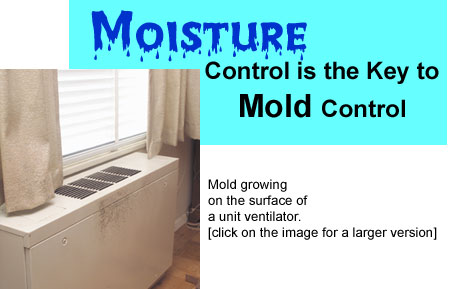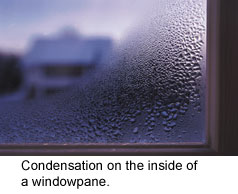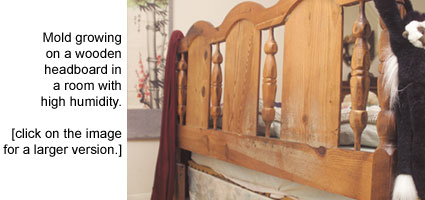|
Mold Basics Mold Cleanup Mold Cleanup Guidelines
What to Wear When Cleaning Moldy Areas
Moisture and Mold Prevention and Control Tips Hidden Mold
 |
|

- Moisture control is the key to mold control, so when water leaks or
spills occur indoors - ACT QUICKLY. If wet or damp materials or
areas are dried 24-48 hours after a leak or spill happens, in most cases
mold will not grow.
- Clean and repair roof gutters regularly.
- Make sure the ground slopes away from the building foundation, so that
water does not enter or collect around the foundation.
- Keep air conditioning drip pans clean and the drain lines unobstructed
and flowing properly.

- Keep indoor humidity low. If possible, keep indoor humidity below 60
percent (ideally between 30 and 50 percent) relative humidity. Relative
humidity can be measured with a moisture or humidity meter, a small,
inexpensive ($10-$50) instrument available at many hardware stores.
- If you see condensation or moisture collecting on windows, walls or
pipes ACT QUICKLY to dry the wet surface and reduce
the moisture/water source. Condensation can be a sign of high humidity.
Actions that will help to reduce humidity:
- Vent appliances that produce moisture, such as clothes dryers,
stoves, and kerosene heaters to the outside where possible. (Combustion
appliances such as stoves and kerosene heaters produce water vapor and
will increase the humidity unless vented to the outside.)
- Use air conditioners and/or de-humidifiers when needed.
- Run the bathroom fan or open the window when showering. Use exhaust
fans or open windows whenever cooking, running the dishwasher or
dishwashing, etc.
Actions that will help prevent condensation:
- Reduce the humidity (see above).
- Increase ventilation or air movement by opening doors and/or
windows, when practical. Use fans as needed.
- Cover cold surfaces, such as cold water pipes, with insulation.
- Increase air temperature.


Testing or Sampling for Mold
Is sampling for mold needed? In most cases, if visible mold growth
is present, sampling is unnecessary. Since no EPA or other federal
limits have been set for mold or mold spores, sampling cannot be used to
check a building's compliance with federal mold standards. Surface
sampling may be useful to determine if an area has been adequately cleaned
or remediated. Sampling for mold should be conducted by professionals who
have specific experience in designing mold sampling protocols, sampling
methods, and interpreting results. Sample analysis should follow
analytical methods recommended by the American Industrial Hygiene
Association (AIHA), the American Conference of Governmental Industrial
Hygienists (ACGIH), or other professional organizations
|
|